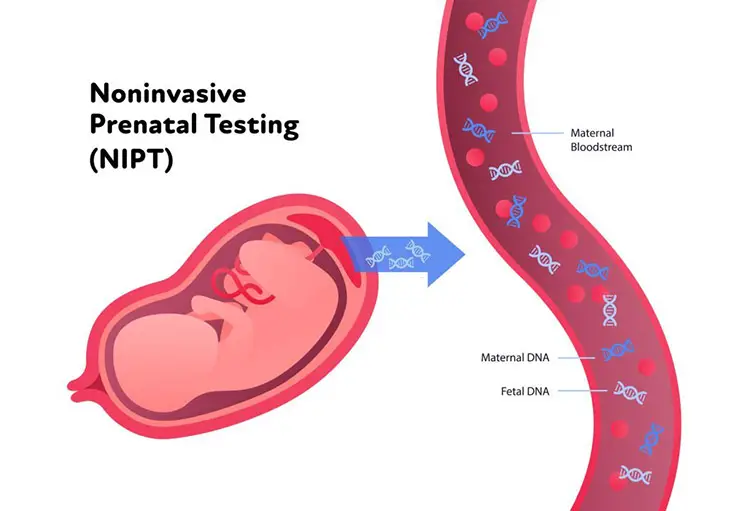What does low fetal fraction mean? Is it a serious problem with your competence in giving birth?
This is a question we have received a lot when it comes to such a medical term.
Worry no longer but let us tell you should or shouldn’t be bothered by the upcoming scenario! Let’s dig in and find out!
What Is A Fetal Fraction?

What does fetal fraction mean? Fetal fraction (FF) is an important quality control metric to aid in interpreting the results of noninvasive prenatal testing (NIPT).
The question is: What does fetal fraction mean on genetic testing? What is fetal fraction on NIPT?
This method of analyzing small fragments of circulating DNA in a pregnant woman’s blood is used to determine the risk that a fetus will be born with certain genetic abnormalities.
Simply put, the fetal fraction (FF) is a crucial part of the noninvasive prenatal testing (NIPT) outcomes quality control process.
To deliver the best post-test counseling and therapeutic therapy, clinicians need to thoroughly understand FF’s molecular implications.
Saying so doesn’t mean your provider needs to be aware of the specifics of the FF measures’ bioinformatics algorithms.
Yet, they do need to be conscious of the major differences between the various sequencing methods employed by various laboratories.
No documented variations in NIPT performance by sequencing platform or FF calculation technique exist, and no universal FF threshold can be used across all platforms.
This is because the laboratory procedures performed and the technologies employed in such a process have to vary widely to provide accurate measurement and reporting of FF.
Without this first step going on the right track, chances are the aftermath of non-invasive prenatal screening for aneuploidy testing will be affected one way or another.
What Does Low Fetal Fraction Mean?

What is low fetal fraction?
Low fetal fraction means that the fetal DNA amount in the mom’s blood sample is too low, below 3.5%, so the test can’t give back an accurate result or there is a chance of genetic abnormalities.
Many studies have claimed that an increased risk for chromosome abnormalities is linked intimately to failed NIPT findings caused by low FF.
This means the lower your fetal fraction, the more likely some genetic abnormalities will be present in a fetus at birth.
Then, does low fetal fraction mean something is wrong?
In most cases, no! There is another more fortunate possibility to take as a reference.
Not like bleeding, which normally means miscarriage, being informed that the fetal fraction is low does not imply that your doctor has discovered an issue with the fetus.
Instead, it simply indicates that there is not enough fetal DNA present in the initial sample for the laboratory test to produce reliable ultrasound findings.
If you feel pain after the ultrasound scan, tell the doctor right away.
It is also significant to note that while FF should be regularly assessed, there is disagreement over whether it should also be regularly reported to the therapist.
The genetic counselors should be the one who can comprehend what to anticipate in a typical diagnostic test report and whether or not the causes of these negative NIPT low fetal fraction results can be disclosed from that report.
Or, say, based on the problems presented by initial samples with low fetal fraction at 10 weeks developed, your provider can develop a new solution to reduce the future failure rates of NIPT test fetal fraction.
What Causes Lower Fetal Fraction NIPT?

There are numerous reasons for low fetal fraction that can lead to the downfall of NIPT.
The list goes on with fetal abnormalities, initial sample mistakes, maternal diseases such as obesity, and fetal cell-free DNA testing for aneuploidy too early in the pregnancy.
Before we get closer to these influences, no matter good or bad, let’s first dig into how the procedure processes.
Little did you know fetal fraction analysis via NIPT can be done in a variety of ways.
The most popular approach for determining chromosomal aneuploidy is counting all cfDNA fragments (both maternal and fetal growth restriction).
As such, the likelihood of the fetus developing a chromosomal disorder will get reduced if the percentage of cfDNA fragments from each chromosome is, as predicted, the so-called negative test result.
Otherwise, the chance of the fetus having a trisomy problem increases if the percentage of cfDNA fragments from a certain chromosome is higher than predicted, the so-called positive trimester ultrasound test result.
That is why a good integrated screening outcome suggests that more invasive testing for aneuploidy, often known as diagnostic testing since it is intended to identify a condition, should be carried out to verify the perinatal outcome.
Why Is Fetal Fraction Important?
As mentioned before, fetal trisomy fraction plays a vastly important role in determining noninvasive prenatal testing platforms (NIPT) ‘s result, not to say the quality outcome of such a procedure depends heavily on this factor.
Not only your clinicians but you must have a good awareness of the molecular implications of fetal cell-free DNA fraction of cell in order to get the hang of your post-test counseling and therapeutic treatment.
This is because aneuploidies may not be identifiable at very low FF concentrations. As a result, you will also have to end up with false-negative findings eventually.
Several NIPT techniques now in use have a fetal fraction cut-off of 4% in order to lessen this danger.
A fresh initial sample is needed if the FF values fall below this cut-off because there is insufficient cell-free DNA fetal fraction present in the initial sample.
What Can Affect Fetal Fraction?
Maternal body mass index (BMI), gestational age (GA), anticoagulant treatment, blood collection, and fetal aneuploidy can all have an impact on your fetal fraction meaning.
Among those, maternal characteristics like weight and maternal age are the variables that impact FF that are most well-known.
Many studies have discovered an adverse relationship between FF and maternal plasma cell-free DNA body weight or BMI (BMI).
Female fetuses’ FF, male fetuses’, and fetuses of any gender all had negative correlations with the mother’s body mass index (BMI) and weight.
BMI was shown to be a significant predictor of FF after adjustment for maternal age and maternal blood risk factors.
Increasing maternal weight or BMI may result in higher levels of maternally produced circulating cell-free DNA.
This is potentially a result of adipocyte necrosis and inflammation, with or without a reduction in placenta-derived cfDNA levels.
It may help to explain why the FF declines when maternal factors like weight or BMI rises.
Several researchers adjusted the FF for maternal age and body mass index before doing multiple regression analyses to examine the variables affecting FF.
The association bias brought on by gestational age and BMI might be avoided this way.
Aside from that, other influences such as maternal age, placental size and function, and so on are no less important to be a part of a fetal fraction failure.
In addition, a decrease in the amount of fetal DNA present in a pregnant woman’s sample can lead to inaccurate results in NIPT tests.
Potentially resulting in misdiagnoses such as Down Syndrome (a chromosomal abnormality involving 21st chromosome) or Edwards Syndrome (a chromosomal abnormality involving 18th chromosome).
How Can I Increase My Fetal Fraction?
It is nothing to panic about as you receive a low fetal fraction result.
There are always approaches for you to improve the situation. Size selection is what we are talking about.
Size selection does not only help improve your fetal fraction, lowers non-invasive prenatal testing failure detection rates, and boosts NIPS clinical performance, but it can also have other advantages you may not expect to benefit from.
That said, this method can as well be useful in circumstances when a greater cell-free fetal DNA fraction is required.
Let’s say you are having twin pregnancies or sub-chromosomal imbalance prenatal screening. Then guess what? You are on the right track to make your gestation smoother!
Conclusion
What does low fetal fraction mean? Now, you have the answer and can take off another burden on the shoulder!
We know these disorders of pregnancy can be harsh to cope with, and there is a lot of stress to struggle with.
Hopefully, with our assistance now and for the days to come, you can anyhow be empowered to a certain extent.
Good luck to you then!
